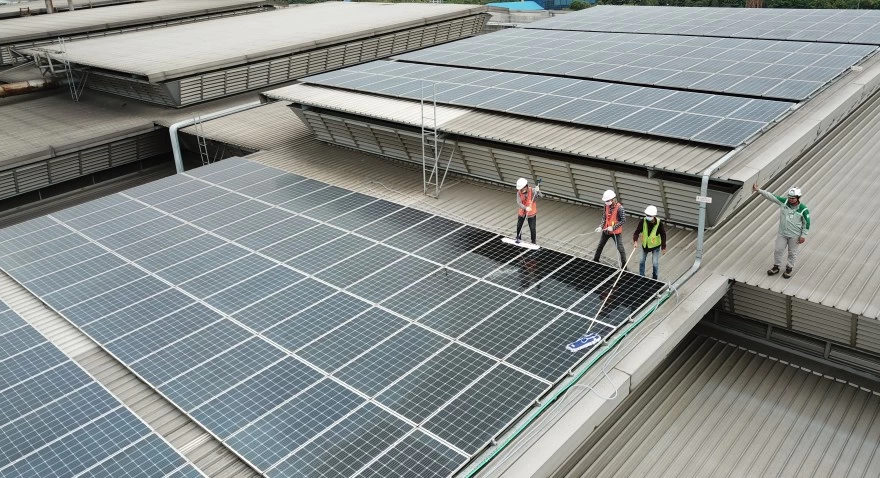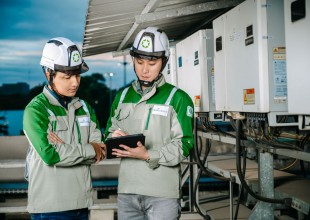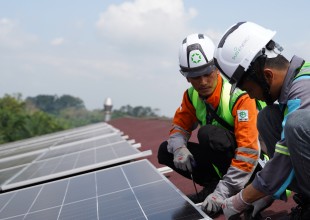The Role of Solar Energy Systems in Advancing Indonesia’s Green Economy

A green economy has become the central strategy for Indonesia’s national development. This concept emphasizes that economic growth must not come at the expense of the environment but should instead move in harmony with sustainability and social welfare. SUN Energy, a leading solar developer in Indonesia with more than 300 solar energy system projects totaling 200 MWp, plays an active role in driving the clean energy transition that aligns with the nation’s green economy agenda.
A study by Indonesia’s Ministry of National Development Planning (Bappenas) estimates that implementing a green economy could increase Indonesia’s average economic growth by 6.3% per year through 2050. In a net-zero emission scenario, growth could be even higher, 6.5% if achieved by 2045, 6.4% by 2050, and 6.1% by 2060.
Beyond driving growth, the green economy is projected to create over 15 million new jobs in environmentally friendly sectors such as renewable energy, sustainable transportation, and green agriculture. These figures highlight that the green economy is not merely a moral obligation in facing the climate crisis, it represents a major opportunity for Indonesia to strengthen its global competitiveness. Amid increasing international carbon regulations, the green economy serves as a crucial pathway for Indonesia to maintain both domestic sustainability and global market relevance.
Solar Energy as the Main Pillar of Green Transition
Renewable energy is the backbone of the transition toward a green economy, and among all sources, solar energy holds the greatest potential in Indonesia. According to the Institute for Essential Services Reform (IESR), the country’s installed solar energy system capacity reached only 718 MWp as of March 2024, far behind its technical potential of 3,295 GWp. This vast gap represents a golden opportunity to accelerate solar energy development.
The government has made solar energy a top priority in the Electricity Supply Business Plan (RUPTL) 2025–2034, targeting 69.5 GW of new power plant capacity, with around 76% coming from renewable energy. Solar energy contributes the largest share, 17.1 GW, underscoring that solar energy systems are no longer optional but a core component of Indonesia’s national energy transition.
The decreasing cost of installation further strengthens solar’s position. The International Renewable Energy Agency (IRENA) reported that the cost of generating electricity from utility-scale solar systems fell by around 85% between 2010 and 2020, making it one of the cheapest energy sources globally. This decline has made solar increasingly affordable for both commercial and industrial sectors, accelerating adoption across Indonesia.
The Tangible Impact of Solar Energy Systems for Industry and Communities
Solar energy systems offer multiple advantages: abundant energy sources, steadily decreasing installation costs, flexible placement, from rooftops and factories to open fields, and long-term cost efficiency for users. A RELE (2024) study found that a 1.1 MWp solar energy system at an Indonesian factory saved nearly IDR 1.7 billion per year on electricity costs, with a payback period of around 7 years. After that, the energy produced becomes essentially free for up to 25–30 years of panel lifespan.
For businesses, such savings are highly significant. The industrial sector is Indonesia’s largest electricity consumer, using around 184 TWh in 2023, accounting for over 40% of national consumption. Therefore, every energy efficiency effort directly impacts production costs and competitiveness. Unsurprisingly, solar energy systems are increasingly being adopted across industries, from manufacturing and retail to automotive, FMCG, and mining.
This trend is reflected in the growth of local solar developers. As of 2025, SUN Energy has developed more than 300 solar energy projects with a total installed capacity of 200 MWp, serving diverse industrial sectors. This portfolio demonstrates how solar energy systems can provide both cost efficiency and support corporate Environmental, Social, and Governance (ESG) goals. It affirms that clean energy transformation in Indonesia’s business landscape is already well underway.
Solar Energy Systems and Global Competitiveness
Beyond lowering energy costs, solar energy systems deliver strategic value for companies. Using clean energy simplifies the process of achieving environmental certifications such as ISO 14001, PROPER Awards, and green building labels, all of which enhance brand reputation and align with environmentally conscious consumer demands.
Moreover, solar energy adoption is directly linked to export competitiveness. Starting in 2026, the European Union’s Carbon Border Adjustment Mechanism (CBAM) will impose additional costs on imports with high carbon footprints, such as steel, cement, fertilizer, and electricity. Products manufactured using fossil-based energy will be subject to these carbon tariffs, whereas companies powered by renewable sources like solar can reduce or even avoid them entirely.
Thus, investing in solar energy systems is not only vital for domestic cost efficiency but also essential for ensuring that Indonesian products remain competitive in global markets. In an increasingly sustainability-driven trade landscape, solar energy offers a comprehensive solution, reducing emissions, cutting costs, and strengthening Indonesia’s position in global supply chains.
***
References:
https://lcdi-indonesia.id/wp-content/uploads/2021/10/GE-Report-versi-Bahasa-6-Oct-lowres.pdf
https://iesr.or.id/wp-content/uploads/2024/10/Launching-Presentation-ISEO-2025-.pdf
https://gatrik.esdm.go.id/assets/uploads/download_index/files/b967d-ruptl-pln-2025-2034-pub-.pdf
https://jurnal.umsu.ac.id/index.php/RELE/article/download/20594/11805
https://data.goodstats.id/statistic/konsumsi-listrik-indonesia-sentuh-430-twh-pada-2025-hxSCU
https://taxation-customs.ec.europa.eu/carbon-border-adjustment-mechanism_en


